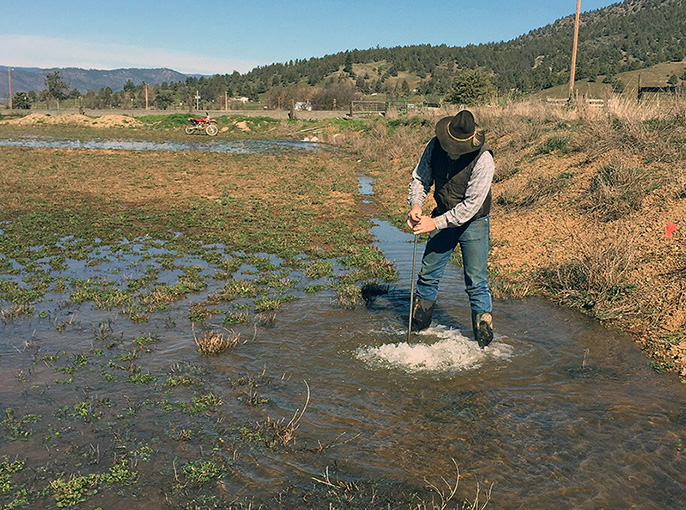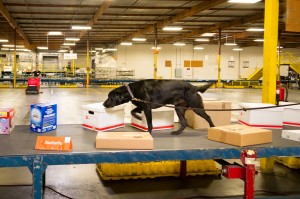By Diane Nelson, UC Davis
Researchers at the University of California, Davis, are encouraged by early results from tests to see if deliberately flooding farmland in winter can replenish aquifers without harming crops or affecting drinking water.
“On-farm flooding looks very promising,” said professor Helen Dahlke, a hydrology expert with the UC Davis Department of Land, Air and Water Resources. “We’re pleasantly surprised by how quickly water tables have responded to on-farm flooding without damage to crops.”
In spring 2015, Dahlke’s team flooded alfalfa at Bryan-Morris Ranch in Siskiyou County, applying more than twice the irrigation the field normally gets in a year. The field produced more weeds than usual, but otherwise, the alfalfa suffered no ill effects.
“It was amazing to see how well the land absorbed the water and how quickly the water table rose,” said Jim Morris, Bryan-Morris Ranch manager. “That’s good news for farming and the environment.”
Dahlke and her team will test flooding on almonds in the Central Valley this winter, looking at plant physiology, infiltration rates, water quality and costs. They are building on previous research involving UC Davis and environmental engineers in the Kings River Basin, where up to 75 percent of diverted floodwater percolated down to aquifers. In that research, scientists flooded pistachios, alfalfa hay and wine grapes.
“Our wine grapes were under water for five months, which raised a few eyebrows, but they did fine,” said Don Cameron, manager of Terranova Ranch along the Kings River in Fresno County. “Diverting floodwater to farms can recharge groundwater and reduce the risk of downstream flooding. It’s a good situation all around.”
California is in chronic groundwater overdraft: There’s more water being pumped from the ground than filtering in. In wet years, gravity helps refill aquifers as land absorbs water from rain, rivers, and snowmelt. In dry years, several water districts help that along by diverting excess water during storms and flood releases into infiltration basins ─ confined areas of sandy soil.
But land dedicated to infiltration is scarce. Can California’s farmland be called into service?
There’s a lot to consider, Dahlke said. Not all soils are particularly permeable, and not all crops can tolerate extra irrigation in the winter. Some soils are especially salty, and some crops need more nitrogen than others.
Researchers wonder whether flooding fertilized farmland or saline soil will leach those chemicals into the groundwater. Or, could on-farm flooding actually improve groundwater quality by diluting salts and nitrates?
Soil expert Anthony O’Geen, a UC Cooperative Extension specialist with the UC Davis Department of Land, Air and Water Resources, recently concluded in the journal California Agriculture that some 3.6 million acres of farmland have good recharge potential because they could likely accommodate deep percolation with little risk of crop damage or groundwater contamination. Pears, wine grapes, many annual crops, and some varieties of almonds, peaches, and plums appear best suited for on-farm flooding, the team found.
“Alfalfa might also be an ideal crop for groundwater banking because it requires little or no nitrogen fertilizer,” O’Geen said.





 Dec. 20
Dec. 20 Jan. 03
Jan. 03 Jan. 10
Jan. 10 Jan. 17
Jan. 17 Jan. 24
Jan. 24 Jan. 31
Jan. 31 Feb. 07
Feb. 07 Feb. 14
Feb. 14 Feb. 21
Feb. 21 Feb. 28
Feb. 28 Mar. 06
Mar. 06 Mar. 13
Mar. 13 Mar. 20
Mar. 20 Mar. 27
Mar. 27 Apr. 03
Apr. 03 Apr. 10
Apr. 10 Apr. 17
Apr. 17 Apr. 24
Apr. 24 May 01
May 01 May 08
May 08 May 15
May 15 May 22
May 22 May 29
May 29 June 05
June 05 June 12
June 12 June 19
June 19 June 26
June 26 July 03
July 03 July 10
July 10 July 17
July 17 July 24
July 24 July 31
July 31 Aug. 07
Aug. 07 Aug. 14
Aug. 14 Aug. 21
Aug. 21 Aug. 28
Aug. 28 Sep. 04
Sep. 04 Sep. 11
Sep. 11 Sep. 18
Sep. 18 Sep. 25
Sep. 25 Oct. 02
Oct. 02 Oct. 09
Oct. 09 Oct. 16
Oct. 16 Oct. 23
Oct. 23 Oct. 30
Oct. 30 Nov. 06
Nov. 06 Nov. 13
Nov. 13 Nov. 20
Nov. 20 Nov. 27
Nov. 27 Dec. 04
Dec. 04 Dec. 11
Dec. 11 Dec. 18
Dec. 18 Dec. 25
Dec. 25 Jan. 01
Jan. 01 Jan. 08
Jan. 08 Jan. 15
Jan. 15 Jan. 22
Jan. 22 Jan. 29
Jan. 29 Feb. 05
Feb. 05 Feb. 12
Feb. 12 Feb. 19
Feb. 19 Feb. 26
Feb. 26 Mar. 05
Mar. 05 Mar. 12
Mar. 12 Mar. 19
Mar. 19 Mar. 26
Mar. 26 Apr. 02
Apr. 02 Apr. 09
Apr. 09 Apr. 16
Apr. 16 Apr. 23
Apr. 23 Apr. 30
Apr. 30 May 07
May 07 May 14
May 14 May 21
May 21 May 28
May 28 June 04
June 04 June 11
June 11 June 18
June 18 June 25
June 25 July 02
July 02 July 09
July 09 July 16
July 16 July 23
July 23 July 30
July 30 Aug. 06
Aug. 06 Aug. 13
Aug. 13 Aug. 20
Aug. 20 Aug. 27
Aug. 27 Sep. 03
Sep. 03 Sep. 10
Sep. 10 Sep. 17
Sep. 17 Sep. 24
Sep. 24 Oct. 01
Oct. 01 Oct. 08
Oct. 08 Oct. 15
Oct. 15 Oct. 22
Oct. 22 Oct. 29
Oct. 29 Nov. 05
Nov. 05 Nov. 12
Nov. 12 Nov. 19
Nov. 19 Nov. 26
Nov. 26 Dec. 03
Dec. 03 Dec. 10
Dec. 10 Dec. 17
Dec. 17 Dec. 24
Dec. 24 Dec. 31
Dec. 31 Jan. 07
Jan. 07 Jan. 14
Jan. 14 Jan. 21
Jan. 21 Jan. 28
Jan. 28 Feb. 04
Feb. 04 Feb. 11
Feb. 11 Feb. 18
Feb. 18 Feb. 25
Feb. 25 Mar. 04
Mar. 04 Mar. 11
Mar. 11 Mar. 18
Mar. 18 Mar. 25
Mar. 25 Apr. 01
Apr. 01 Apr. 08
Apr. 08 Apr. 15
Apr. 15 Apr. 22
Apr. 22 Apr. 29
Apr. 29 May 06
May 06 May 13
May 13 May 20
May 20 May 27
May 27 June 03
June 03 June 10
June 10 June 17
June 17 June 24
June 24 July 01
July 01 July 08
July 08 July 15
July 15 July 22
July 22 July 29
July 29 Aug. 12
Aug. 12 Aug. 19
Aug. 19 Aug. 26
Aug. 26 Sept. 2
Sept. 2 Sept. 09
Sept. 09 Sept. 16
Sept. 16 Sept. 23
Sept. 23 Sept. 30
Sept. 30 Oct. 07
Oct. 07 Oct. 14
Oct. 14 Oct. 21
Oct. 21 Oct. 28
Oct. 28 Nov. 4
Nov. 4 Nov. 11
Nov. 11 Nov. 18
Nov. 18 Nov. 25
Nov. 25 Dec. 02
Dec. 02 Dec. 09
Dec. 09 Dec. 23
Dec. 23 Jan. 06
Jan. 06 Jan. 20
Jan. 20 Feb. 3
Feb. 3 Feb. 10
Feb. 10 March 3
March 3 March 10
March 10 March 17
March 17 March 24
March 24 March 31
March 31 April 7
April 7 April 21
April 21 April 28
April 28 May 5
May 5 May 12
May 12 May 19
May 19 May 26
May 26 June 2
June 2 June 9
June 9 June 16
June 16 June 23
June 23 June 30
June 30 July 7
July 7 July 14
July 14 July 21
July 21 July 28
July 28 Aug. 4
Aug. 4 Aug. 11
Aug. 11 Aug. 18
Aug. 18 Aug. 25
Aug. 25 Sept. 1
Sept. 1



